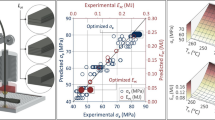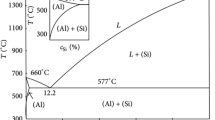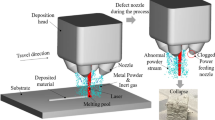Abstract
Calibration procedures for constitutive models for powder compaction are presented. A practical calibration method based on a die compaction experiment is presented. A newly developed apparatus consisting of a die instrumented with radial stress sensors is described. The paper proposes two contributions to account for errors present in instrumented die testing, which are due to 1) elastic compliance of the testing frame, influencing the measurement of axial strain and 2) the presence on non-homogeneous stress state in the test specimen. It is shown that system compliance is important for generating an accurate stress-strain curve for compression. The effect of different compliance correction methods is evaluated with regard to the accuracy of models predicting pressing forces. The system compliance becomes more significant during unloading in the die; this information is used to determine the elastic properties. A new compliance correction method is introduced following a detailed analysis of the forces and deformations of different parts of the loading frame. In instrumented die compaction the axial and radial stresses are measured at fixed locations and the specimen is subject to non-homogeneous stresses and strains due to the effect of friction between the powder and die wall. Starting from the Janssen-Walker method of differential slices a method to account for non-homogeneous stress and strain is developed.


















Similar content being viewed by others
References
Schofield A, Wroth CP (1968) Critical state soil mechanics. McGraw-Hill, London
Drucker DC, Prager W (1952) Soil mechanics and plastic analysis or limit design. Q Appl Math 10:157–165
Gurson AL (1977) Continuum theory of ductile rupture by void nucleation and growth: part I, yield criteria and flow rules for porous ductile media. J Eng Mater-T ASME 99:2–15
Tvergaard V (1981) Influence of voids on shear band instabilities under plane strain condition. Int J Fract Mech 17:389–407
Trasorras JRL, Parameswaran R, Cocks ACF (1998) Mechanical behaviour of metal powders and compaction modelling. In: ASM Handbook, vol. 7: Powder metal technologies and applications. ASM International, pp 326–342
Cocks ACF (2001) Constitutive modelling of powder compaction and sintering. Prog Mater Sci 46:201–229
Zavaliangos A (2002) Constitutive models for the simulation of P/M processes. Int J Powder Metall 38:27–39
Sinka IC (2007) Modelling powder compaction. Kona 25:4–22
Cocks ACF, Sinka IC (2007) Constitutive modelling of powder compaction—I. Theoretical concepts. Mech Mater 39:392–403
Fleck NA (1995) On the cold compaction of powders. J Mech Phys Solids 43:1409–1431
Akisanya AR, Cocks ACF, Fleck NA (1997) The yield behaviour of metal powders. Int J Mech Sci 39:1315–1324
Schneider L, Cocks ACF (2002) An experimental investigation of the yield behaviour of metal powder compacts. Powder Metall 45:237–245
PM Modnet Research Group (2002) Numerical simulation of powder compaction for two multilevel ferrous parts, including powder characterisation and experimental validation. Powder Metall 45:335–344
Brewin PR, Coube O, Doremus P, Tweed JH (2008) Modelling of powder die compaction (engineering materials and processes). Springer, London
Koerner RM (1973) A new pressing method: triaxial compression. Ceram Bull 52:566–568
Doremus P, Geindreau C, Martin A, Debove L, Lecot R, Dao M (1995) High pressure triaxial cell for metal powder. Powder Metall 38:284–287
Sinka IC, Cocks ACF, Morrison CJ, Lightfoot A (2000) A high pressure triaxial facility for powder compaction. Powder Metall 43:253–262
Sinka IC, Cocks ACF, Tweed JH (2001) Constitutive data for powder compaction modelling. J Eng Mater-T ASME 123:176–183
Sinka IC, Cocks ACF (2007) Constitutive modelling of powder compaction—II. Evaluation of material data. Mech Mater 39:404–416
Shima S, Oyane M (1976) Plasticity theory for porous metals. Int J Mech Sci 18:285–291
Timoshenko SP, Goodier JN (1970) Theory of elasticity. McGraw-Hill, New York
Dean GD, Loveday MS, Cooper PM, Read BE, Roebock B, Morrell R (1995) Chapter 8 Aspects of modulus measurement. In: Dyson BF, Loveday MS, Gee MG (eds) Materials metrology and standards for structural performance. Chapman & Hall, pp 150–209
ASTM E111—04 Standard test method for Young’s modulus, tangent modulus, and chord modulus. ASTM International, West Conshohocken
Kalidindi S, Abusafieh A, El-Danaf E (1997) Accurate characterization of machine compliance for simple compression testing. Exp Mech 37:210–215
Guyoncourt D, Tweed JH, Gough A, Dawson J, Pater L (2001) Constitutive data and friction measurements of powders using instrumented-die. Powder Metall 44:25–33
Wu CY, Ruddy OM, Bentham AC, Hancock BC, Best SM, Elliott JA (2005) Modelling the mechanical behaviour of pharmaceutical powders during compaction. Powder Technol 152:107–117
Bier W, Dariel MP, Frage N, Hartmann S, Michailov O (2007) Die compaction of copper powder designed for material parameter identification. Int J Mech Sci 49:766–777
Han LH, Elliott JA, Bentham AC, Mills A, Amidon GE, Hancock BC (2008) A modified Drucker-Prager Cap model for die compaction simulation of pharmaceutical powders. Int J Solids Struct 45:3088–3106
Nedderman RM (1992) Statics and kinematics of granular materials. Cambridge University Press, Cambridge
Sinka IC, Cunningham JC, Zavaliangos A (2001) Experimental characterization and numerical simulation of die-wall friction in pharmaceutical powder compaction. In: Proc. PM2TEC 2001 International Conference on Powder Metallurgy & Particulate Materials Part 1. MPIF Princeton, pp 46–60
Sinka IC, Cunningham JC, Zavaliangos A (2004) Analysis of tablet compaction. Part 2—Finite element analysis of density distribution in convex tablets. J Pharm Sci 93:2040–2052
Gethin DT, Ariffin AK, Tran DV, Lewis RW (1994) Compaction and ejection of green powder compacts. Powder Metall 37:42–52
Sinka IC, Cunningham JC, Zavaliangos A (2003) The effect of wall friction in the compaction of pharmaceutical tablets with curved faces: a validation study of the Drucker–Prager Cap model. Powder Technol 133:33–43
Martin CL (2003) Unloading of powder compacts and their resulting tensile strength. Acta Mater 51:4589–4602
Acknowledgements
C. Shang acknowledges the Mechanics of Materials Research Group at Leicester University for a partial PhD scholarship. Many thanks to Dr. Simon Lawes, the Experimental Officer in our Group, for his support.
Author information
Authors and Affiliations
Corresponding author
Rights and permissions
About this article
Cite this article
Shang, C., Sinka, I.C. & Pan, J. Constitutive Model Calibration for Powder Compaction Using Instrumented Die Testing. Exp Mech 52, 903–916 (2012). https://doi.org/10.1007/s11340-011-9542-8
Received:
Accepted:
Published:
Issue Date:
DOI: https://doi.org/10.1007/s11340-011-9542-8




